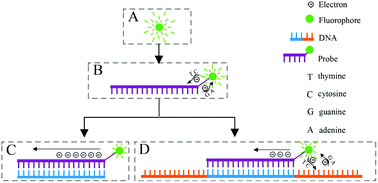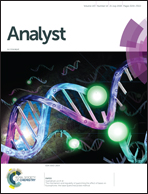The mechanism and regularity of quenching the effect of bases on fluorophores: the base-quenched probe method†
Abstract
The base-quenched probe method for detecting single nucleotide polymorphisms (SNPs) relies on real-time PCR and melting-curve analysis, which might require only one pair of primers and one probe. At present, it has been successfully applied to detect SNPs of multiple genes. However, the mechanism of the base-quenched probe method remains unclear. Therefore, we investigated the possible mechanism of fluorescence quenching by DNA bases in aqueous solution using spectroscopic techniques. It showed that the possible mechanism might be photo-induced electron transfer. We next analyzed electron transfer or transmission between DNA bases and fluorophores. The data suggested that in single-stranded DNA, the electrons of the fluorophore are transferred to the orbital of pyrimidine bases (thymine (T) and cytosine (C)), or that the electron orbitals of the fluorophore are occupied by electrons from purine bases (guanine (G) and adenine (A)), which lead to fluorescence quenching. In addition, the electrons of a fluorophore excited by light can be transmitted along double-stranded DNA, which gives rise to stronger fluorescence quenching. Furthermore, we demonstrated that the quenching efficiency of bases is in the order of G > C ≥ A ≥ T and the capability of electron transmission of base-pairs in double-stranded DNA is in the order of C![[G with combining low line]](https://www.rsc.org/images/entities/b_char_0047_0332.gif) ≥ G
≥ G![[C with combining low line]](https://www.rsc.org/images/entities/b_char_0043_0332.gif) > T
> T![[A with combining low line]](https://www.rsc.org/images/entities/b_char_0041_0332.gif) ≥ A
≥ A![[T with combining low line]](https://www.rsc.org/images/entities/b_char_0054_0332.gif) (letters representing bases on the complementary strand of the probe are bold and underlined), and the most common commercial fluorophores including FAM, HEX, TET, JOE, and TAMRA could be influenced by bases and are in line with this mechanism and regularity.
(letters representing bases on the complementary strand of the probe are bold and underlined), and the most common commercial fluorophores including FAM, HEX, TET, JOE, and TAMRA could be influenced by bases and are in line with this mechanism and regularity.



 Please wait while we load your content...
Please wait while we load your content...